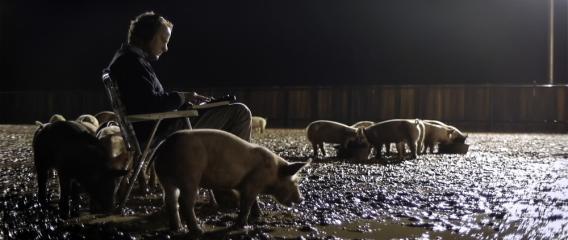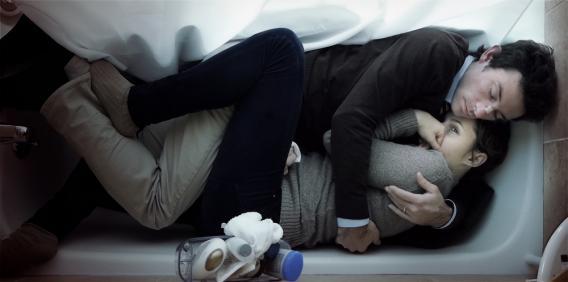Spoilers ahead. And explanations.
Q. I just saw Upstream Color. What … just happened?
A. Upstream Color is about two people, Kris (Amy Seimetz) and Jeff (director and screenwriter Shane Carruth), whose lives and behaviors are affected by a complex parasite—without them even knowing it. The parasite has a three-stage life cycle in which it passes from humans to pigs to orchids. Carruth eloquently calls this the “worm-pig-orchid life cycle.”
Q. Who are all those other people? The guy with the frizzy hair and the pigs, or the guy who steals all Kris’s money?
A. At each stage of the worm-pig-orchid cycle there’s someone who profits from that stage and, unknowingly, advances the parasite to the next stage. The first person, whom the credits call the Thief (played by Thiago Martins), infects victims with the worm to brainwash them and steal their money. We see him do this to Kris, and we learn that he’s also done this to Jeff.
The second person, whom the credits call the Sampler (Andrew Sensenig), takes the worms from the Thief’s victims and puts them into pigs. The transfer of the worm establishes a connection between the victim and the pig, and the Sampler can then use the pigs to “sample” the victims’ experiences—each time he approaches a victim’s pig, he can see what’s going in that victim’s life. The Sampler is then inspired by these experiences to record music, which he sells through his record company, Quinoa Valley Rec. Co.
The third person, or actually the third group of people, are the two orchid farmers—the credits call them the Orchid Mother (Kathy Carruth) and the Orchid Daughter (Meredith Burke). When the Sampler disposes of pigs by bagging them and throwing them into a nearby stream, the parasite leaches out of the pigs and into white orchids, turning them blue. The two orchid farmers then pick these rare blue orchids and sell them through their company, E+P Exotics.
The Thief then buys these rare blue orchids—at the beginning of the film we can see that the flower pots he buys are labeled E+P Exotics—and uses the worms that come out of them, beginning the W-P-O cycle anew.

© erbp 2012
Q. So how exactly does this affect Kris and Jeff?
A. Well, first it costs them their life savings. When the worm is inside the Thief’s victims, it makes them susceptible to being put in a hypnotic trance. During this trance, the Thief orders his victims to sell their possessions, take out mortgages on their houses, etc. This goes on until the victims eat, which in turn gives the parasite, currently in the stomach, food to feed on and grow, at which point the worm extends all the way to the ends of each of the victim’s limbs.
Q. How does the Sampler find the worm-victims, then?
A. He uses amplifiers to send vibrations into the ground to draw in the Thief’s victims, in a version of a real technique called “worm charming,” and transplants the worms from the victims into pigs. The victims are now no longer under the Thief’s control, but each victim is now linked with the pig in which his worm resides. This means not only that they can be spied on one at a time by the Sampler—they’re now called “The Sampled,” according to the credits—but also that they’re subject to being influenced by whatever happens to their pig. We first see this after Kris’ pig and Jeff’s pig come nose to nose in the corral. This leads Kris and Jeff to pair up, too, though they’re not quite able to explain their attraction to each other at first.

© erbp 2012
Q. So why do Kris and Jeff start freaking out and beating up interns and stuff?
A. It starts when Kris’ pig gets pregnant. Kris, in turn, becomes convinced that she also is pregnant (even though she isn’t). When the piglets are born, and the Sampler comes to take the piglets away, that’s when things go really wrong. This makes Kris’ pig and Jeff’s pig angry and scared, because someone is taking away their kids, which is why Kris and Jeff, too, come to feel angry and scared. When Jeff’s pig is finally locked away, this makes Jeff feel so angry and so trapped that he beats up a couple interns and runs away.
When Kris’ pig and Jeff’s pig are finally reunited, the pigs feel traumatized and huddle together in fear; Kris and Jeff do the same, gathering their things and huddling in the bathtub.

© erbp 2012
Q. Why does Kris then start hearing things and diving for stones in a pool? And how does this lead them to the pig corral and the Sampler?
A. The exact mechanics of this aren’t 100 percent clear to me, but Carruth insists that the trauma of losing her piglets sends Kris into a “fugue state,” and the power of this emotion leads to her breakthrough:
Kris is on a path to basically get to a psychic break, because she is dealing with the mania and hysteria of having her children be taken from her, without her ever being able to consciously know that she even has children. So she is experiencing a level of, in my mind maybe the greatest, the most powerful emotion you might be able to feel… is what I might imagine it might feel, for a mother to lose her children. She is experiencing that, without anything to point out to explain why. That was always going to lead to this break that she has, where she winds up almost in a fugue state, swimming at the pool reciting lines from Walden. So that’s roughly why she’s on the trajectory that she’s on.

© erbp 2012
Q. Why does Kris kill the Sampler? It’s not clear that he’s a bad guy.
A. Kris probably thinks the Sampler is the Thief. Remember, Kris has never seen the Thief’s face, and it’s natural that she would assume that whoever has been spying on her and messing with her pig is also the person that put her in this position in the first place. Carruth has said roughly as much himself:
The idea that Kris would find [the Sampler] culpable, and make him pay that price for what’s been done to her, is hopefully an interesting coda. I mean she’s basically supplanting one false narrative with another. But she will never know that, and she can’t know that. And it’s only for the audience to realize, hopefully, after some reflection, that although the ending felt and looked like somebody finding the culprit, and getting their own peacefulness and resolution—in reality there’s almost nothing positive about what we’re looking at. The wrong person is “gotten.”

© erbp 2012
Q. Why Walden?
A. Carruth says that initially he chose Walden simply because he “didn’t at first like [it], and thought it would be perfect for hypnotizing someone.” He’s elaborated elsewhere that its uneventfulness makes it perhaps especially useful to the Thief, because there’s not much in it that could snap someone out of a trance.
He’s also said he wanted a book that was grounded in nature, to match the themes and aesthetic of the film, and as he was making the film certain passages began to pop out. For example, there’s a passage about “a low and seemingly very distant sound … gradually swelling and increasing” (though, in Walden, it turns out only to be the sound of an ice drift). There’s also this striking passage from Walden about the actual parasites inside us, highlighted by Movie City News:
We are conscious of an animal in us, which awakens in proportion as our higher nature slumbers. It is reptile and sensual, and perhaps cannot be wholly expelled; like the worms which, even in life and health, occupy our bodies. Possibly we may withdraw from it, but never change its nature. I fear that it may enjoy a certain health of its own; that we may be well, yet not pure.
Q. Why pigs?
A. Luckily, somebody asked this at a Q&A I attended. For one thing, Carruth chose them because he knew they would stay put. You couldn’t have the Sampler chasing around chickens. Furthermore, he didn’t want anything too exotic; it wouldn’t fit the look of the film. Finally, he chose them because they’re physiologically fairly similar to humans, meaning it’s easier to imagine a parasite passing between us and them.

© erbp 2012
Q. What is that weird symbol that plays before the movie?
A. It’s just Carruth’s production logo. He’s distributing the movie himself.
Q. Why is the movie called Upstream Color?
A. Carruth offered his explanation in an interview with IndieWire:
Well, in the film the main characters are being affected at a distance by things they can’t speak to. And the three points in the triangle, as far as the worm-pig-orchid cycle, each of them are performing acts that are independent of the next one in the line… they would all be dealing with things that seemingly came from “upstream.” And “color” … I think of it as building up a personal narrative, and the shape of that is easy, the color is what’s difficult. I don’t know if that means anything, but it seemed appropriate to me at the time.
Q. Wait—did that answer make any sense?
A. I mean, sorta.
Q. But what does it all mean?
A. Carruth wants people to take away a fairly specific interpretation, though he prefers that people come to it on their own. Still, when pressed at all, he’s mentioned in several interviews and Q&As that the film, for him, is about identity, “about whether we control our identity or whether our identity controls us.” He elaborated, to io9:
It’s meant to be universally about all of these things that are not able to be spoken about clearly that we suspect are affecting us—whether that’s people’s religious beliefs or cosmic beliefs or even hidden biological processes. Just all of the things that make you suspect the reasoning for, ‘Why did I do that?’ Or, ‘Why am I doing this tomorrow?’ ‘Why does someone else think this way?’ It’s all of that.
Q. What if I don’t like that interpretation?
A. Good news! There are plenty of alternate interpretations out there. Some connect to it because of experiences with drug addiction, or codependent relationships. Here are two other interpretations from other critics.
Q. C’mon. Does it actually all hold together logically?
A. Probably. It’s worth noting that Carruth is the guy who made Primer, which has a byzantine but apparently entirely coherent internal logic, which only emerges in full when you’ve seen it enough times. That said, Upstream Color is also, like the Coens’ A Serious Man, about mystery. You could, if you choose to, “accept the mystery.”
Q. Will it make a little more sense if I see it again?
A. Definitely.
